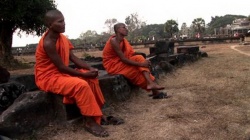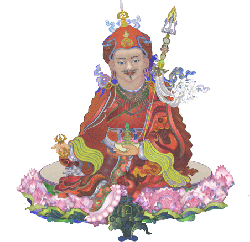Songs of realization
Songs of realization, or "Songs of Experience'" (Tibetan: ཉམས་མགུར, Wylie: nyams mgur; Devanāgarī: दोहा; Romanized Sanskrit: Dohā; Oriya: ପଦ) are sung poetry forms characteristic of the tantric movement in both Hinduism and in Vajrayana Buddhism.
Doha is also a specific poetic form. Various forms of these songs exist, including caryagiti (Sanskrit: caryāgīti), or 'performance songs' and vajragiti (Sanskrit: vajragīti, Tibetan: rDo-rje gan-sung ),
or 'diamond songs', sometimes translated as vajra songs and doha (Sanskrit:dohā), also called doha songs, distinguishing them from the unsung Indian poetry form of the doha.
According to Roger Jackson, caryagiti and vajragiti "differ generically from dohās because of their different context and function", the doha being primarily spiritual aphorisms expressed in the form of rhyming couplets whilst caryagiti are stand-alone performance songs and vajragiti are songs that can only be understood in the context of a ganachakra or tantric feast.
Many collections of songs of realization are preserved in the Tibetan Buddhist canon, however many of these texts have yet to be translated from the Tibetan language.
Although many of the songs of realization date from the mahasiddha of India, the tradition of composing mystical songs continued to be practiced by tantric adepts in later times and examples of spontaneously composed verses by Tibetan lamas exist up to the present day, an example being Khenpo Tsultrim Gyamtso Rinpoche.
The most famous Tibetan composer of songs of realization is Milarepa, the 11th century Tibetan yogi whose mgur bum, or 'The Hundred Thousand Songs of Milarepa' remains a source of instruction and inspiration for Tibetan Buddhists, particularly those of the kagyu school.
Rangjung Dorje (1284–1339) wrote a 'doha' (Sanskrit) entitled Distinguishing Consciousness from Wisdom (Wylie: rnam shes ye shes ‘byed pa).
Caryagiti songs
A renowned collection of Buddhist caryagiti, or mystical songs, is the Charyapada, a palm-leaf manuscript of the 8th-12th century text having been found in the early 20th century in Nepal.
Another copy of the Charyapada was preserved in the Tibetan Buddhist canon.
Miranda Shaw describes how caryagiti were an element of the ritual gathering of practitioners in a tantric feast:
- The feast culminates in the performance of tantric dances and music that must never be disclosed to outsiders. The revelers may also improvise "songs of realization" (caryagiti) to express their heightened clarity and blissful raptures in spontaneous verse.
Doha songs
Ann Waldman describes this poetry form:
- the doha, a song of realization that acknowledges an encounter with a master teacher, traditionally a guru or lama, and explores a particular wisdom or teaching transmitted through a kind of call-and-response duet format.


